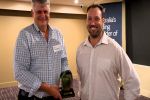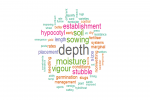Key points
- Award-winning barley grower Charles Caldwell values the data produced via the Hyper Yielding Crops initiative
- He aims to lift the whole-farm average using information gleaned from the initiative
- He has learned many lessons by taking part, including the importance of timing for all operations, not just sowing
Charles Caldwell is keen on using data produced in the Hyper Yielding Crops initiative to boost gross margins on average paddocks
Two years after first entering GRDC’s Hyper Yielding Crops (HYC) initiative and producing an award-winning crop, Western Australia grain grower Charles Caldwell has changed tack.
He is less interested in producing a massive crop from his best paddock and more interested in using the data collected by entering awards to improve performance and boost gross margins on average paddocks.
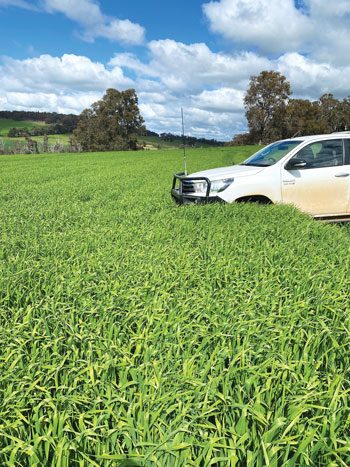 The Caldwells’ award-winning 2022 crop of RGT Planet (PBR), which yielded 7.76t/ha and won the regional Hyper Yielding Crops category for highest yield based on the percentage of yield potential (84 per cent). Photo: supplied by Charles Caldwell
The Caldwells’ award-winning 2022 crop of RGT Planet (PBR), which yielded 7.76t/ha and won the regional Hyper Yielding Crops category for highest yield based on the percentage of yield potential (84 per cent). Photo: supplied by Charles Caldwell
Charles, who farms with his wife Dana and parents Anthony and Pauline at Scotts Brook and Boyup Brook in south-west Western Australia, entered his best paddock in the 2022 awards when they were expanded to include barley as well as wheat in WA, Victoria and South Australia.
That crop of RGT Planet barley, which yielded 7.76 tonnes per hectare, won the category for highest yield based on percentage of yield potential for the region, achieving 84 per cent.
The Caldwells followed up last year with a crop of RockStar wheat that yielded 4.14t/ha, which was 56.79 per cent of yield potential – the highest in the region.
The RockStar was sown on 28 May into canola stubble on loamy sand at a rate of 120 kilograms/ha on 228-millimetre row spacings and was harvested on 17 December.
After a dry start, the growing season rainfall tally of 392mm was skewed by high rainfall in June.
The crop’s yield potential was assessed at 7.29t/ha. Charles says the actual yield reflected the impact of the 2023 season’s dry finish on cereal grain fill, with very little rain recorded after mid-September and above-average temperatures from August onwards.
Data generated
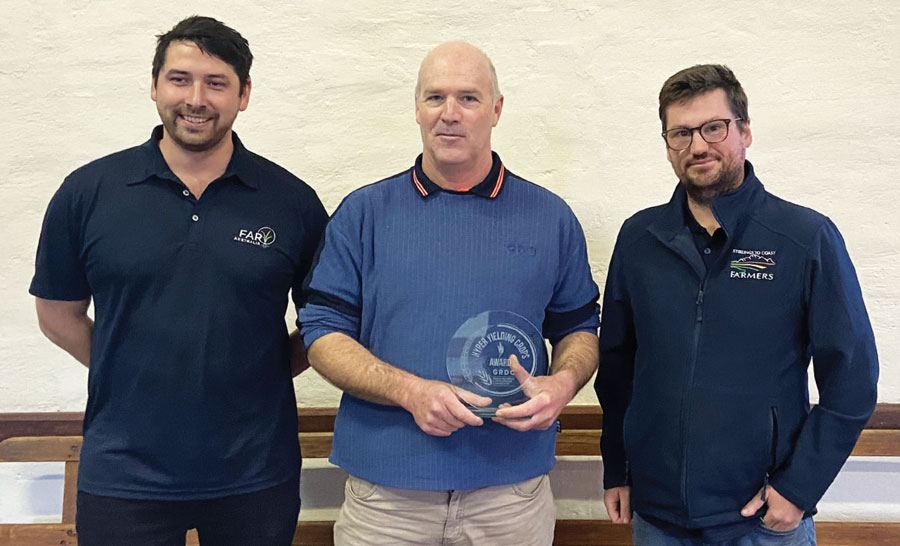 FAR Australia senior research manager Darcy Warren (left) and Stirlings to Coast Farmers R&D coordinator Dan Fay (right) present Charles Caldwell with his trophy for a 2023 crop of RockStar wheat that yielded 4.14t/ha, which was 56.79 per cent of yield potential and the highest in the region. Photo: supplied by Charles Caldwell
FAR Australia senior research manager Darcy Warren (left) and Stirlings to Coast Farmers R&D coordinator Dan Fay (right) present Charles Caldwell with his trophy for a 2023 crop of RockStar wheat that yielded 4.14t/ha, which was 56.79 per cent of yield potential and the highest in the region. Photo: supplied by Charles Caldwell
In 2022, the first year he entered the awards, Charles chose a paddock based on gut feel. That was confirmed when it produced the highest barley yields on the farm.
In 2023, an average-performing paddock was chosen. “I think it was a good result last year, considering the rainfall cut-off. The canola was solid, but the cereals suffered.”
Charles says he thought it would be more helpful to enter a middling paddock in the initiative because of the huge amount of data, such as additional soil testing and grain nutrient analysis, collected as part of the process.
“We took a slightly different tack with it to get the best agronomic benefit from the experience and replicate this on average paddocks,” he says. “To me, the point is to lift the whole-farm average of your cropping ... Profit per hectare is the endgame.”
A comparison with other WA paddocks entered in the HYC showed his applied nitrogen of 180kg/ha was well above the WA average, potassium was higher than average and phosphorus was near average.
Topsoil tests showed Colwell K was very low and pH and DGT-P were low, while copper, manganese, sulfur and zinc were at acceptable levels, and organic carbon and Colwell P were high.
Grain quality analysis found nitrogen was very high and copper was high, while potassium, phosphorus and manganese were acceptable, and sulfur and zinc were marginal.
Protein was 12.2 per cent, test weight 79.55 kilograms per hectolitre and screenings 5.1 per cent, while plant tissue analysis showed the sample was deficient in boron.
Lessons learned
Charles participates in field tours, visiting other farms and the Field Applied Research (FAR) Australia field days at its Frankland River trial site. He says they are useful to learn from other growers, advisers and FAR Australia staff about what they are doing and how new varieties are performing. Other lessons learned during the past two years of taking part in HYC include the importance of timing for all operations, not just sowing.
It’s been disease management, nutrition timing and then just making sure that everything through the year is done on time, and getting the crop in early enough that the variety can maximise its growing potential.
“Based on some of the things we’ve learned, we’ve tailored our nutritional package to better balance it. In 2023, some of those grain test analyses came back quite high in protein, so this year we’ve done a little bit less nitrogen, but a bit more on the trace elements, which were still showing up a bit deficient.”
Even though the dry finish slashed last year’s cereal yields, Charles does not expect to ever hit 100 per cent of yield potential.
“If we’d had finishing rains, I would be confident it could have done 6t/ha or better, but it wouldn’t have been 100 per cent,” he says. “There’s always something to keep improving on.”
Liming program
A liming program was started 10 years ago in a bid to lift pH to a more desirable window of 5.5 to 6.0.
Because much of the soil is gravelly and non‑wetting with a high phosphorus buffering index (PBI), the Caldwells apply 21 to 22 units of phosphorus. This is done as a blend of Macro Pro 85 per cent and Ag manganese 15 per cent at 130 to 140kg/ha.
After tissue analysis showed boron deficiency in last year’s wheat, Charles has applied foliar boron to the canola now growing in that paddock to check for a response.
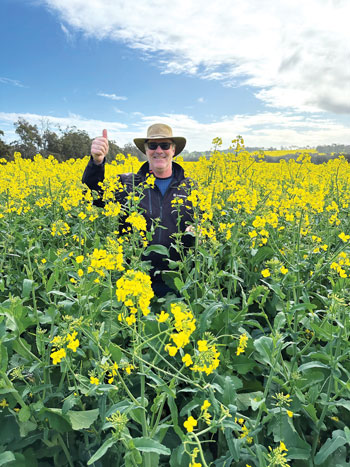 Charles Caldwell in a field of Pioneer 45Y28RR canola in September 2024. Photo: supplied by Charles Caldwell
Charles Caldwell in a field of Pioneer 45Y28RR canola in September 2024. Photo: supplied by Charles Caldwell
He has also moved from two in-crop applications of nitrogen to three as “more of a drip feed through the year”, reducing the risk of losses from leaching or volatilisation.
For the past four years, the rotation has been canola followed by a cereal crop of barley or wheat. The Caldwells have grown lupins in the past but are unable to justify including them more often because of the poorer returns compared with canola.
Average yields have been 2.8 to 3t/ha for canola, which Charles attributes to new genetics that have “come ahead in leaps and bounds”, and barley yields have ranged from 5t/ha to 7t/ha.
After experiencing significant losses from frost about eight years ago, they have only returned to wheat in the past two years.
Crops in 2024 include RGT Planet , Neo CL and Zena CL barley, RockStar and Valiant wheat, Bannister oats, and three varieties of canola: Invigor R 4520P, Pioneer PY525G and Pioneer 45Y28RR.
After a dry start, rain in May helped even up the staggered germination and further rain in August has set the crops up for a good result.
“If the crops carry on as they are this year, I’m pretty hopeful of 3t/ha canola and 6t/ha cereals,” he says. “We just need a good finishing rain to bring it home.”
Wish list
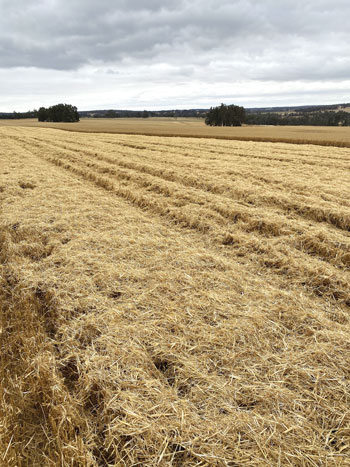 Charles Caldwell would like to see research into techniques for seeding into heavy cereal stubble – and boosting organic matter – without having to burn it. Photo: supplied by Charles Caldwell
Charles Caldwell would like to see research into techniques for seeding into heavy cereal stubble – and boosting organic matter – without having to burn it. Photo: supplied by Charles Caldwell
Charles’s wish list includes further research into integrated pest management strategies and new control options for insects, such as redlegged earth mite, lucerne flea and aphids, given the development of pesticide resistance and the European Union’s tightening rules.
He would also like to see more research in WA’s higher-rainfall zone to identify cereal varieties that suit this climate, methods for building up organic matter with a profitable legume, or techniques for seeding into heavy stubble without having to burn it.
“Where we’ve tried it (seeding into heavy stubble without burning), the crop establishment is compromised because there’s just so much stubble loading. You might get through barley stubble with a seeder but there’s lumps of straw that have covered the seed furrow, so the canola can’t germinate through it. Plants per square metre is compromised with seeding through a barley stubble here; if it’s a decent (previous) crop, it’s a major issue.”
As well as cropping, the Caldwells have built up a herd of 250 mostly Angus breeders, which are being joined to Angus bulls to produce heifers and steers that will be turned off at an age or weight that suits the market.
Until three years ago, they ran 10,000 Merino and crossbred sheep, but his property Silverstone was put into quarantine after an outbreak of foot rot and most of the flock sold or culled.
Charles practises diversification and risk management. “Some paddocks here are probably a bit too wet in an average year for cropping,” he says. “So we’ll earmark the wetter paddocks for grazing, and then the well-drained cropping paddocks are in crop continuously.”
The HYC initiative led by FAR Australia spanned the high-rainfall areas of Victoria, SA, Tasmania, southern NSW and WA and concluded in 2024.
More information: Charles Caldwell, charliewell@hotmail.com



